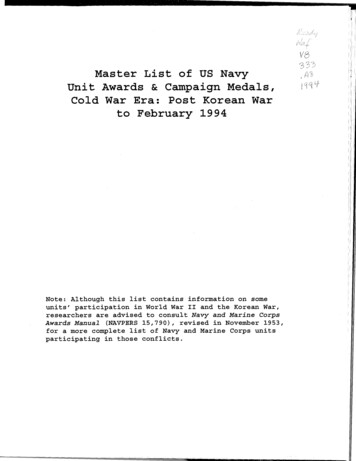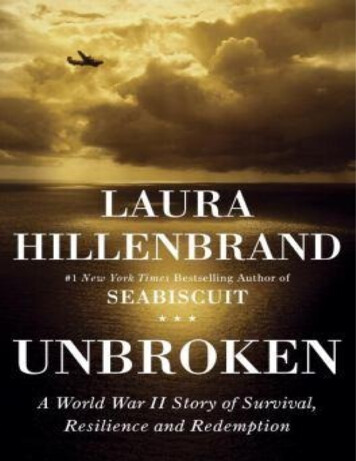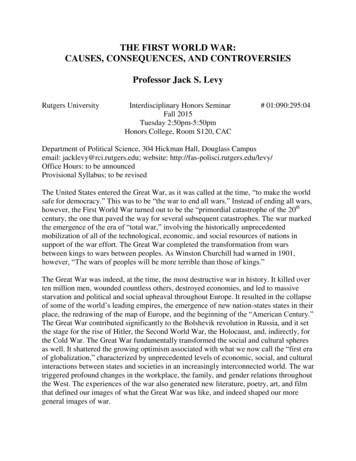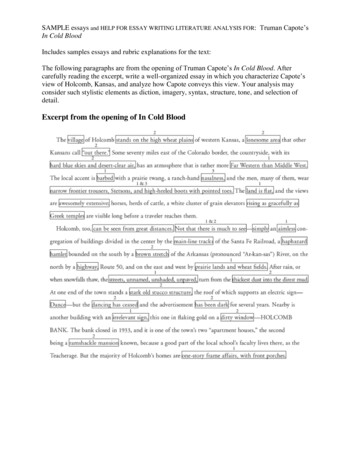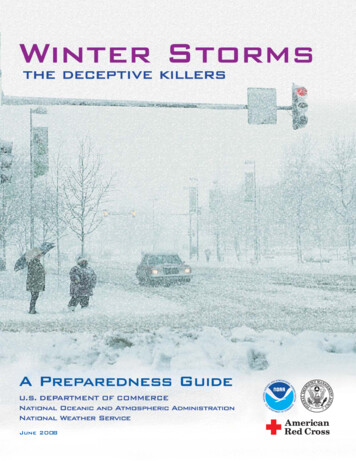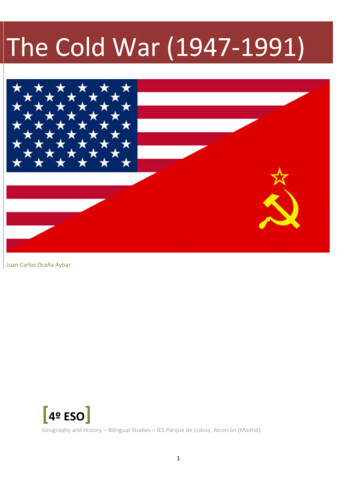
Transcription
The Cold War (1947-1991)Juan Carlos Ocaña Aybar[4º ESO]Geography and History – Bilingual Studies – IES Parque de Lisboa, Alcorcón (Madrid)1
The Cold War (1947-1991)IntroductionThe Grand Alliance formed by the U.S., USSRand the UK in World War II managed to defeatEuropean fascism and Japanese expansionism,but began to crumble even before Allied troopsoccupied Berlin. Two years later, the Allies hadbroken their friendship. The Cold War began, along period of rivalry (1947-1991) which pittedthe U.S. against the Soviet Union and theirrespective allies and determined internationalrelations for almost half a century.Soviet soldiers in Berlin, May 1945Potsdam conference, the alliance started to crumble, July 1945The Cold War was fought on the political, economic, and propaganda fronts. There was nodirect military confrontation between the two nuclear superpowers: the U.S. and the USSR.Such a conflict would have led to a nuclear holocaust on the planet. However, multiple wars inother locations punctuated the period. In almost all of these conflicts, the two superpowers andtheir allies supported diplomatically and armed the contenders. The Cold War ended with thecollapse of the Soviet bloc. Weapons did not defeat the USSR, but the ineffectiveness of itseconomic system and the lack of political freedoms.2
The world is divided into blocks: 1945-1955The settlement of the communist system in European countries conquered by the Red Armyalarmed Western leaders. Churchill proclaimed in 1946 that an "Iron curtain" separatedcommunist Europe from free Europe. In 1947, U.S. President Truman expressed theirwillingness to implement a policy of "containment of communism" to prevent its expansion toGreece and other parts of world. To achieve this goal, the US implemented the Marshall Plan,an economic plan that sent aid to Europe. The goal of this plan was to prevent theimpoverishment of the populations that favoured European communist expansion.The first stage of the Cold War took place in the defeated country of Germany. The country hadbeen divided into four occupation zones: British, French, American and Soviet. The city ofBerlin was similarly divided. Soon there were increased differences between Western and Sovietauthorities. The rupture between the former allies led to the division of Germany. In 1949, theFederal Republic of Germany, in the western zones, and the German Democratic Republic inthe Soviet zone, were born. Henceforth, throughout the Cold War, there existed two Germanys,one a democratic and capitalist, the other a Soviet-style communist dictatorship.That same year the Cold War moved to Asia. The victory of Mao Zedong's communist forces ledto the proclamation in October 1949 of the Republic of China. The world's most populouscountry joined the communist bloc.3
Mao Zedong proclaiming the People’s Republic of ChinaTo further increase Western anxiety, a few months before the Soviet Union had detonated itsfirst atomic bomb. Thereafter the two nuclear powers could face off anywhere in the world.Joe-1, the American nickname for the first Soviet atomic test, referred to Joseph Stalin.The new point of conflict arose again in Asia. The Korean War (1950-1953) led to the partitionof Korea into two antagonistic countries. The North was a tight communist regime backed by theUSSR and China, while the South was a US-backed military dictatorship.The Korean War clearly showed the global dimension to the Cold War. Henceforth, Asia becameone of the main stages for the Cold War.4
The Bipolar World 1949-1955The partition of Germany and the Korean War showed the world a new reality: a division intotwo separate blocs led by the United States and the USSR. Thereafter, each block defended itshinterland against the advance of their opponent block.U.S. took various measures to establish its global influence. First, it reinforced its ties withWestern Europe. NATO (the North Atlantic Treaty Organization) was created in 1949. Thegreat Western bloc military alliance is still in existence to this day. Second, Washington pushedthe European integration process that culminated in 1957 with the birth of the EuropeanEconomic Community. Finally, the U.S. wove a network of anti-Soviet alliances worldwide.The Soviet bloc was strengthened by the victory of Mao Zedong in 1949. The USSR signedmilitary agreements and cooperation with communist China of Mao.Finally, in 1955, the Warsaw Pact created a military alliance that joined the USSR with allEuropean countries of the communist bloc with the exception of Yugoslavia.Peaceful Coexistence 1955-1962Stalin's death in 1953 and the rise to power of a new Soviet leader, Khrushchev opened a newperiod in the Cold War. After a period of great tension, a new and more diplomatic climate inrelations developed between Washington and Moscow, which led to talk of "peacefulcoexistence" and "thaw". However, this new environment did not mean the end ofinternational crises. In this period the Berlin Wall was erected and the Cold War came toAmerica with the Cuban Missile Crisis. It was also during these years when, to the delight U.S.,5
that the two communist giants, China and the USSR, broke their alliance and becameantagonistic powers.The main factor that led to the "thaw" in relations between the two superpowers was what wascalled the "balance of terror", i.e. the situation created after the conversion of the USSR toatomic power and accelerated rearmament for both powers. There was a general certainty that awar between the superpowers would lead to mutual destruction of both and much of theplanet.Paradoxically, during the new period of peaceful coexistence were two of the most serious crisesof the Cold War: the construction of the Berlin Wall and the Cuban Missile Crisis.From 1951 to 1958 the German Democratic Republic (GDR), the German Communist, had seenmore than two million East Germans fled to West Germany. The differences in living standardsand lack of freedoms prompted this exodus of the population.On August 13, 1961, before the astonished eyes of the Berliners, the GDR authorities beganbuilding an impenetrable wall that would surround the entirety of western Berlin. As it wasknown in the West, the "wall of shame" became the great symbol of the Cold War.Two years earlier, with the triumph of the Cuban Revolution, Fidel Castro took the Cold Warat the gates of the U.S. Hostility culminated when the US failed to invade the island and wererepulsed by Castro's forces in Playa Girón. The Cuban Revolution was, in principle, was notcommunist, but the revolutionaries sided with the communist bloc. The U.S. aggression allowedCuban dictator to ask the USSR to deploy nuclear missiles to its territory.When U.S. spy planes detected missile ramps, Kennedy reacted by declaring a blockade of theisland and announcing in October 22, 1962 that the U.S. Navy would prevent the passage of anySoviet ship to be routed to the island. The world held his breath at the prospect of an incident thatcould lead to fatal nuclear escalation. Finally, on October 29, Khrushchev relented and gave theorder to their ships to turn back. The USSR agreed to remove the missiles from Cuba inexchange for the U.S. commitment not to invade the island. The worst crisis of the Cold War hadpassed.6
The next major event of this period was great news for the United States. The two communistgiants, the USSR and China, broke relations and initiated a period of deep hostility.Ideological and strategic rivalries led communist bloc excision.The Détente 1962-1975After peeking "over the edge" in the nuclear missile crisis in Cuba, Kennedy and Khrushchevdecided to start a more systematic and enduring policy of détente. This opened a new ColdWar period in which agreements between the superpowers did not prevent serious conflicts suchas Vietnam or the Middle East.Among the treaties highlighted was the NPT (Nuclear Non-Proliferation Treaty), signed in 1968by the U.S., the USSR, and the United Kingdom and the SALT I (Strategic Arms Limitation)Agreement (1972) which limited the number of intercontinental missiles that the USSR and theUSA could own.Nixon and Khruschev after signing SALT treatyThe détente did not prevent local conflicts from degenerating into bloody wars in which bothsuperpowers intervened.The Middle East conflict, which began with the birth of the state of Israel in 1948, reached apeak with the "Six Day War" in 1967 and the Yom Kippur War in 1973. Both conflictsbrought major changes in the region: Israel, with U.S. support, went from being a small countrybesieged by enemies to becoming the hegemon of the region and occupied Palestinian territoriesand part of Syria.7
Israeli troops observing old JerusalemArab countries reacted by using oil as an economic weapon against Western countries thatsupported Israel. The oil price increases that followed the Yom Kippur War in 1973 triggered the"oil crisis" that marked the end of a long period of expansion of capitalism in the developedcountries.The war in Vietnam, a country ravaged by conflict since the Second World War, is the biggesthumiliation of the U.S. during the Cold War. After a long war in the that saw the US shippinghalf a million soldiers and not hesitating to use chemical weapons and massive bombings, theU.S. government had to accept defeat. It was impossible to defeat North Vietnam and theVietcong guerrillas, who were supported by the USSR. In 1975, Vietnam was reunified undera communist government.8
The New Cold War 1975-1985The Western world's economic difficulties following the "oil crisis" of 1973 and the Americanreluctance to engage militarily abroad after the failure of Vietnam encouraged Moscow tointervene in various areas of the world. It was a mirage. American weakness was apparent. TheSoviet was real. However, its economy had entered a period of stagnation that ultimately led tothe collapse of the communist system. US President Reagan in the eighties returned to apolicy of confrontation with the Soviet Union and the USSR could not cope with the newchallenge that came from Washington. The Soviet economic weakness precipitated the end ofthe Cold War and the subsequent collapse of the USSR.The USSR international misread the situation and launched an expansion of its internationalinfluence regardless of the serious difficulties that depleted its economy. The last period in theSoviet leadership of Leonid Brezhnev (1964-1982) witnessed what can be called a deceptiveSoviet expansion: In Asia, Vietnam was reunified in 1975 under a communist government.In Central America, the Sandinista revolution of 1979 established a revolutionaryregime in Nicaragua with the support of Moscow and Havana.In Africa, the Soviet expansion was even more spectacular. Starting in 1974, pro-Sovietregimes in Ethiopia, Angola, and Mozambique were established.9
The Sandinista revolution in NicaraguaHowever, the Soviet expansion was based upon a feeble and stagnant economy. In 1985, anew leader took over power in Moscow: Mijail Gorbachov. Pushed by the serious economicsituation, Gorbachov launched a reformist program called the “Perestroika”, which eventuallydismantled the communist bloc (the Berlin Wall fell in 1989) and led to the collapse of theSoviet Union in 1991 and consequently the end of the Cold War.Mijail Gorbachev, the last leader of the USSR10
The Cold War began, a long period of rivalry (1947-1991) which pitted the U.S. against the Soviet Union and their respective allies and determined international relations for almost half a century. Potsdam conference, the alliance started to crumble, July 1945 The Cold War was





